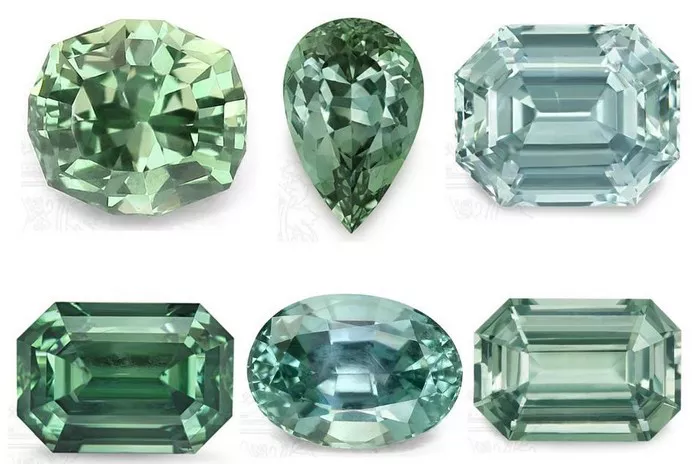Sapphires are renowned for their stunning blue hues, but they also come in a variety of other colors, including the less commonly known green sapphire. This gemstone, with its distinctively verdant shades ranging from delicate pastels to deep forest greens, captivates gem enthusiasts and collectors alike. However, its rarity and uniqueness in the gemstone world often lead to questions regarding its availability, origin, and value.
Understanding Green Sapphire
Sapphire is a variety of the mineral corundum, composed of aluminum oxide with trace elements influencing its coloration. While blue sapphire owes its color primarily to iron and titanium, green sapphire’s greenish hues are typically due to the presence of iron and chromium. The exact combination and concentration of these elements determine the intensity and shade of green exhibited by the stone.
Green sapphires can display a range of colors from light mint greens to deep emerald tones. Sometimes, they may exhibit secondary hues such as yellow or blue, influencing their overall appearance and desirability. The most valuable green sapphires are those with a pure green hue without significant secondary colors, particularly in deeper saturations.
Rarity Factors
Natural Occurrence
One of the primary factors contributing to the rarity of green sapphire is its natural occurrence. Sapphires are formed under specific geological conditions involving high temperatures and pressures within metamorphic or igneous rock formations. The introduction of chromium and other elements during formation influences the stone’s color, with green sapphires requiring a precise balance of trace elements for their distinctive hue.
Green sapphires are typically found in regions known for sapphire deposits, such as Sri Lanka (Ceylon), Madagascar, Australia, and certain parts of Africa. However, even within these regions, green sapphires are far less common than their blue counterparts. This scarcity is partly due to the less frequent geological conditions that produce the necessary chemical compositions for green coloration.
Mining and Production
The mining of green sapphires is another contributing factor to their rarity. Unlike diamonds, which are often mined on a large scale, sapphires, including green sapphires, are usually found in smaller quantities and require careful extraction. Many sapphire mines are small-scale operations, with miners meticulously sorting through gravel and sediment in search of gem-quality stones. This labor-intensive process further limits the availability of green sapphires on the market.
Additionally, the production of green sapphire jewelry involves skilled lapidary work to cut and polish the stones to highlight their color and brilliance. Gem cutters must carefully consider the stone’s natural characteristics to maximize its aesthetic appeal, adding another layer to the gem’s rarity.
Rarity in Relation to Other Gemstones
Comparing with Other Sapphires
In comparison to blue sapphires, which are among the most popular and widely recognized gemstones globally, green sapphires are significantly rarer. Blue sapphires have historically dominated the market due to their association with luxury and tradition, particularly in engagement rings and fine jewelry. This preference has led to extensive mining efforts focused on blue sapphire deposits, further highlighting the scarcity of green sapphires by comparison.
Rarity Among Colored Gemstones
Within the spectrum of colored gemstones, green sapphire occupies a unique position. While green gems such as emeralds and tourmalines are celebrated for their vivid green hues, green sapphire offers a distinct alternative with its durability and brilliance. Its rarity makes it a desirable choice for collectors and individuals seeking gemstones that stand out from more common options like rubies or amethysts.
Factors Influencing Value
Color Intensity and Clarity
The value of a green sapphire is influenced primarily by the intensity and purity of its green color. Stones with a vivid, saturated green hue and minimal secondary colors command higher prices, especially if they exhibit excellent transparency and clarity. Inclusions within the stone, while common in natural sapphires, can affect its transparency and overall beauty, thus impacting its market value.
See Also: Which Zodiac Signs Should Not Wear Ruby: A Beginner’s Guide
Cut and Carat Weight
The cut of a green sapphire plays a crucial role in enhancing its brilliance and color. Well-cut stones maximize the light reflection within the gem, intensifying its green hues and enhancing its visual appeal. The carat weight of the stone also affects its value, with larger, high-quality green sapphires being particularly rare and therefore more valuable per carat compared to smaller stones of similar quality.
Rarity and Market Demand
The rarity of green sapphire contributes significantly to its market value, as collectors and connoisseurs often seek out unique and exceptional specimens. Trends in jewelry design and consumer preferences can also influence demand for green sapphire, impacting its availability and pricing on the market. As awareness of green sapphire grows and appreciation for its distinctive beauty expands, its value as a collectible gemstone continues to rise.
Investment Potential
For investors and collectors, green sapphire presents an intriguing opportunity due to its rarity and potential for appreciation over time. While market conditions and trends can fluctuate, rare gemstones like green sapphire often retain or increase their value, particularly when accompanied by gemological certifications confirming their quality and authenticity.
Investing in green sapphire requires careful consideration of factors such as provenance, quality, and market demand. As with any investment in gemstones, consulting with experienced gemologists and reputable dealers can provide valuable insights and guidance to navigate the complexities of the gemstone market.
Conclusion
In conclusion, green sapphire is indeed a rare and captivating gemstone prized for its distinctive green hues and rarity in the world of colored gemstones. Its scarcity, influenced by geological factors, mining practices, and market demand, underscores its value and allure among collectors and jewelry enthusiasts alike. Whether admired for its natural beauty, considered as an investment, or chosen for its symbolism in jewelry, green sapphire continues to fascinate and inspire with its timeless appeal and enduring elegance. As appreciation for colored gemstones grows, green sapphire stands out as a testament to nature’s artistry and the enduring allure of rare and beautiful gems.

